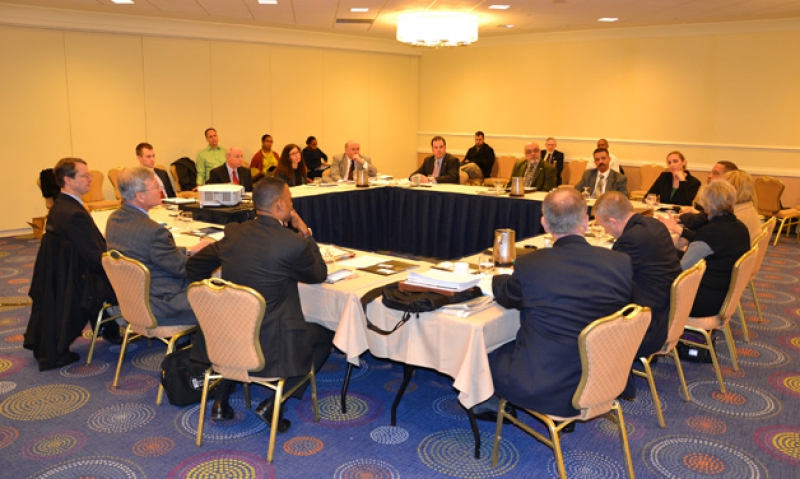
Homeless Veterans Roundtable in DC
Participants in The American Legion’s Homeless Veterans Workshop on Feb. 24 in Washington, D.C., pooled their knowledge on how to reduce, and ultimately eliminate, homelessness among the men and women who have served America in uniform with honor. Before sharing their thoughts, the group watched a short video presentation that highlighted some of the Legion’s efforts to help veterans without homes, including successful programs in Connecticut, New Jersey and Pennsylvania.
Pete Dougherty, from the Department of Veterans Affairs (VA), said the video “portrayed what most of us would agree on -- that eliminating this problem takes a collaborative effort, mostly at the local level.” At the federal level, progress continues with VA Secretary Eric Shinseki’s pledge to eliminate veterans’ homelessness by 2015. “Before, we didn’t really have the tools,” Dougherty said. “We now have the sort of tools we need to do the job.” Those tools include a significant amount of permanent housing, ongoing health-care services for veterans with serious physical and mental disabilities, and a lot of reliable data from other service providers about homeless veterans in their communities.
“If you don’t provide ongoing health-care services, they sometimes deteriorate and become homeless once again. Some veterans do very well in transitional housing, but others need longer-term care,” Dougherty said.
In its current budget, VA has $100 million for preventive efforts that include funding for nonprofits and community collaborations that help veterans who are on the verge of becoming homeless. Federal funding for the prevention of veterans’ homelessness is a recent development; in the past, VA could not do much for veterans until they actually became homeless.
Many veterans with families, Dougherty said, have been reluctant to get help because their sons and daughters would have to live elsewhere. But the Housing and Urban Development-Veterans Affairs Supported Housing (HUD-VASH) program is turning that problem around because it provides permanent homes to veterans and their families. “Eleven percent of HUD-VASH recipients are women, and 28 percent of those have children,” Dougherty said. “They know that they and their children have a safe place to live.”
Permanent housing set aside for veterans and their families remains in that status, noted Mark Johnston of HUD. “When one veteran leaves, (the home) is only used for other veterans.” He explained that some funding is used for “rapid rehousing,” a newer strategy that puts veterans into temporary housing with short-term subsidies (about four to five months). Johnston said that 75 percent of veterans in the rapid rehousing program have families, and only six percent fell back into homelessness.
“Most homeless veterans don’t need permanent housing. They need rapid rehousing,” Johnston said. While VA “is fantastic” on outreach and placement of veterans into HUD-VASH housing, it cannot -- by law -- cover such things as security deposits, beds, furniture, kitchen utensils and other household items. “This is how The American Legion can be engaged,” he said. “A nominal investment, a thousand dollars per veteran, will help a lot.” HUD is working with foundations in 14 cities that provides furniture and other essentials to veterans for their homes.
The Department of Labor’s Veterans Employment and Training Service (VETS) got a 34 percent increase in funding for 2010, about $35 million, according to VETS representative Ken Fenner. "That money provided 144 grants nationwide, many of them focusing on the needs of homeless female veterans. We realized we didn’t know much about them,” Fenner said. “What it takes to get the homeless female to show up (for assistance). We need to find out what’s working and what’s not.”
In 2010, VETS helped about 16,000 homeless veterans and 9,000 of those got jobs.
“Employment is one component that really does break the back of veteran homelessness,” Fenner said. “Without that, it is arguable that we’re only putting a temporary band-aid on it.”
John Driscoll of the National Coalition for Homeless Veterans gave the roundtable some good, hard numbers that showed real progress. The number of homeless veterans declined from more than 300,000 in 2003 to less than 100,000 in 2010. Today, the estimate stands at about 67,000. Of those, 35,000 are chronically homeless and about 1.4 million veterans live in poverty.
Driscoll said that even if VA achieves its goal of getting 60,000 HUD-VASH vouchers by 2014, it will still fall short on the permanent housing it needs to achieve the five-year plan by about 33,000 units. He said that gap could be filled by about two million foreclosed or abandoned houses nationwide, and that The American Legion and American Legion Auxiliary could expand its efforts into this area.
“It is an absolute honor to be with The American Legion today,” Driscoll said. “Your voice goes into communities that the federal government never heard of. Where I live, The American Legion is the most important voice for veterans.”
Other roundtable participants included Ian Lisman, National Alliance to End Homelessness; Michael Ferrell, Coalition of the Homeless; Marie Galbraith, Tampa Crossroads; Teresa Fava-Schram, Central New York Veterans Outreach Center; Gary Profit, Walmart; and Hakeem Basheerud-Deen, Office of Personnel Management.
The American Legion was represented by Dale Barnett, chairman of the Legion’s National Economic Commission; and Mark Walker, deputy director of the Legion’s Economic Division. Nancy Brown-Park represented The American Legion Auxiliary.
